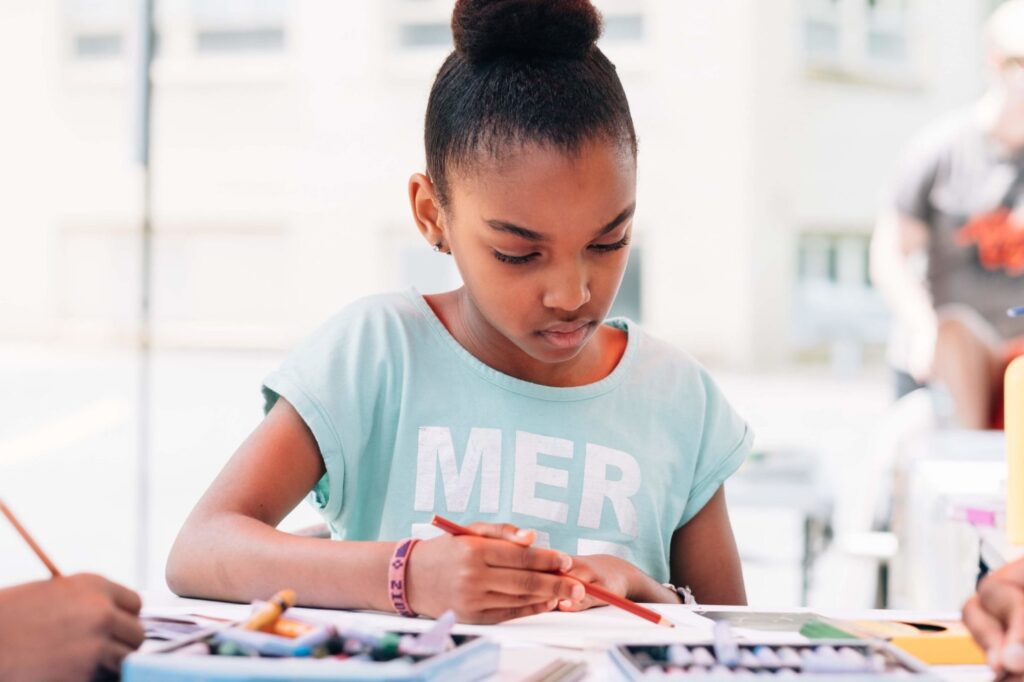In an increasingly technological world, arts education may seem secondary. Why color, when you can code? Why paint, when you can 3D print? It’s the often-overlooked letter in STEAM, and in recent years, it’s the first to hit the budgetary chopping block.
As we’ve previously explored, arts education—defined broadly as learning related to visual and performing arts, like drawing, painting, sculpture, dance, theater, and music—helps learners build the skills they’ll need to succeed in future workplaces. Research shows that arts education furthers problem-solving, critical thinking, creativity, innovation, communication, and collaboration. Plus, it helps learners build other skills they’ll need as citizens of a global world, like empathy and cross-cultural understanding.
In short, if we hope to remake learning we must support arts-based learning. But, for its many crucial benefits, arts education can only impact those students who are afforded access to opportunities.
Impact Requires Access
Historically, those with the most access are white and affluent learners, families, and schools. Black learners and learners of color, those from low-income families, and other underserved populations are often left with few avenues for financially accessible, high-quality arts learning.
As cited by Americans for the Arts, in 2008, Black and Hispanic students had less than half of the access to arts education than their white peers. Similarly, in 2016, the arts-focused National Assessment of Educational Progress found that the largest gaps existed along lines of race and income and could be traced back to differences in opportunity and exposure.
On a scale of 300, students eligible for free and reduced-price lunch scored an average of 26 points lower in music than those not eligible, and 22 points lower in visual arts. Black students scored 29 points lower in music and 30 points lower in visual arts. According to assessment officials, learners who did well tended to have more exposure to music and the arts, something that’s tied directly to family resources.
At the same time, these inequities are exacerbated by schools, institutions, and governments cutting arts education funding and maintaining a blind focus on state standardized test scores. As reported by Brookings:
“Over the last few decades, the proportion of students receiving arts education has shrunk drastically. This trend is primarily attributable to the expansion of standardized-test-based accountability, which has pressured schools to focus resources on tested subjects. …. These pressures have disproportionately affected access to the arts in a negative way for students from historically underserved communities.”
And so we arrive at an inflection point: Arts education can help students build crucial academic and life skills, but social, political, and administrative realities are making this type of learning available only to the wealthiest and whitest students.
Partnerships Provide the Way Forward
To forge a way forward, many schools have looked beyond the bounds of formal education, forming collaborative partnerships with community arts organizations. Together, they are creating more financially accessible and culturally relevant opportunities for students, while also building the crucial case for officials and policymakers to reinvest in in-school arts curriculum. Exploring this idea, last year Brookings conducted the first large-scale study of a city’s collective efforts to restore arts education through community partnerships and investments. They focused on the initial two years of Houston’s Arts Access Initiative and its work to create equitable arts access for every student in the Houston Independent School District.
Initial results underscored the importance and necessity of arts learning—finding that “substantial increase in arts educational experiences has remarkable impacts on students’ academic, social, and emotional outcomes.” Researchers concluded by strongly encouraging policymakers to consider these many benefits when making decisions related to the provision of the arts in schools, as they will continue to play a pivotal role in cultivating the next generation of citizens and leaders.
In Action Across the Network
Across the Remake Learning network, members are forming their own in-school/out-of-school partnerships to help restore and maintain equitable, culturally relevant arts learning for Black learners, LGBTQ+ youth, and others.
Since its founding in 1968 by Bill Strickland, Manchester Craftsmen Guild has honed a nationally recognized afterschool arts program for high school students, offering ceramics, design arts, digital arts, and photography. Pittsburgh Public Schools’ students can attend courses for free, and MCG has partnered with the Allegheny County Department of Human Services and various charter schools to offer school day art education in group homes and classrooms.
Arts Greenhouse, a project of Carnegie Mellon University, partners with local schools to offer on-site studios during the school year and summer. The initiative collaborates with classroom teachers to determine a track of study (like 2D art, music production, or poetry) and develop related lessons.
Ujamma Collective provides weekly community arts programming to girls at Arsenal Middle School, delivering a blend of study in arts, making, culture, entrepreneurship, and more.
In addition to those offering blended programming, many members also offer accessible, arts-based enrichment and after school programs. ProjectArt Pittsburgh hosts free after-school art classes (taught by culturally responsive resident artists) at six public libraries across Pittsburgh. The Hope Academy offers several programs in theater, music, and dance, as do the Legacy Arts Project, Level Up Studios, and Hip Hop on L.O.C.K. Arts Out Loud and Rainbow Writers of Write Pittsburgh focus on creative expression and arts for LGBTQ+ youth.
These programs, projects, and organizations are just a few of many that model the way forward for arts education in our region. They’re helping to build a future where every young person can benefit from the arts and, in turn, help us all to shape a more just, equitable, and beautiful world.
In the weeks ahead, we’ll be looking at some of these and others in more detail. Stay tuned!
